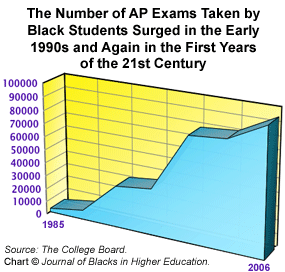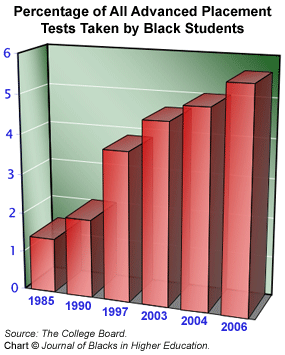Major Defeat for Affirmative Action
 In a major blow to efforts to bring more racial diversity to the nation’s newsrooms, the Dow Jones News Foundation has agreed to end its summer internship program for minority students. The agreement was in response to a lawsuit filed by the Center for Individual Rights on behalf of a 15-year-old white student from Virginia who was accepted into the program and then told she could not attend when the university found out she was white. The lawsuit claimed the exclusion of white students violated the Equal Protection Clause of the Fourteenth Amendment to the U.S. Constitution. In a major blow to efforts to bring more racial diversity to the nation’s newsrooms, the Dow Jones News Foundation has agreed to end its summer internship program for minority students. The agreement was in response to a lawsuit filed by the Center for Individual Rights on behalf of a 15-year-old white student from Virginia who was accepted into the program and then told she could not attend when the university found out she was white. The lawsuit claimed the exclusion of white students violated the Equal Protection Clause of the Fourteenth Amendment to the U.S. Constitution.
The High School Journalism Workshops for Minorities were established in the 1960s. Black and other minority students would spend two weeks during the summer at university journalism schools or at news organizations around the country. The workshops often led to college scholarships for high-achieving students and job offers from news organizations.
Now the programs will be open to students of all races.
The universities that held journalism workshops for minority students included the University of Alabama, Virginia Commonwealth University, New York University, Penn State University, the University of Miami, and Marquette University. Workshops were also held at Florida A&M University, the University of Kentucky, Seattle University, and the University of Missouri.
  |
“Boston University should be embarrassed by such low numbers. Those are deplorable numbers. In 2007, that is not acceptable.”
— Boston city council member Charles Yancey, an African American, commenting on the fact that blacks are 2.6 percent of the student body, in the Daily Free Press, the student newspaper at Boston University, February 5, 2007 (See story below.)
|
MIT to Conduct Study of Its Faculty Hiring Practices: Black Professor Ends Hunger Strike
 The administration of the Massachusetts Institute of Technology has agreed to make a formal inquiry into the hiring and promotion practices involving minority faculty members. The decision was announced just days before James L. Sherley, an African-American associate professor of biological engineering at MIT, began a hunger strike demanding that the university admit that racism played at least some role in the decision to deny him tenure. In February 2005 Sherley had been presented with MIT’s Martin Luther King Jr. Leadership Award for “his enthusiastic commitment to education and science and his exemplary work as a scientist, teacher and laboratory head who has fostered an inclusive and supportive environment.” The administration of the Massachusetts Institute of Technology has agreed to make a formal inquiry into the hiring and promotion practices involving minority faculty members. The decision was announced just days before James L. Sherley, an African-American associate professor of biological engineering at MIT, began a hunger strike demanding that the university admit that racism played at least some role in the decision to deny him tenure. In February 2005 Sherley had been presented with MIT’s Martin Luther King Jr. Leadership Award for “his enthusiastic commitment to education and science and his exemplary work as a scientist, teacher and laboratory head who has fostered an inclusive and supportive environment.”
 Professor Sherley ended his hunger strike late last week saying that he had successfully brought “attention to bear on issues of equity, diversity, and justice at MIT.” Professor Sherley ended his hunger strike late last week saying that he had successfully brought “attention to bear on issues of equity, diversity, and justice at MIT.”
Of the 998 full-time faculty members at MIT there are 188 women and 54 minorities. The latest JBHE survey on black faculty at the nation’s leading universities found that there were 28 blacks teaching at MIT making up 2.9 percent of the full-time faculty.
For Blacks, Unlike Other Minorities, Education Plays No Role in Likelihood of Interracial Marriage
A study published in this month’s edition of the American Sociological Review finds a large decline in interracial marriages among some ethnic groups. But not so for African Americans. In addition, the study found that interracial marriages vary to a great degree depending on level of education.
Authors Daniel Lichter of Cornell University and Zhenchao Qian of Ohio State University found that fewer Hispanics and Asian Americans are marrying people from different ethnic groups than was the case in the 1990s. The authors believe that increasing populations of Asian and Hispanic immigrants have resulted in more opportunities for intraracial marriages and therefore people in these groups have been less likely to look for partners with a different ethnic background.
The study concluded that African Americans are far less likely than Asians or Hispanics to be involved in interracial marriages. But unlike Asians and Hispanics, interracial marriages have not decreased for blacks in recent years. About 15 percent of black men who marry choose a spouse of a different race or ethnic background. This is up from 8 percent in 1990. Today, more than a third of Hispanic men and half of Asian-American men who marry have spouses from a different racial or ethnic group. The rate of interracial marriage for both Hispanic and Asian-American men has decreased by about five percentage points since 1990.
The authors also found that rates for interracial marriage for Asians and Hispanics tended to rise as they moved up the educational ladder. For example, Hispanic women with a college education were three times more likely to be involved in an interracial marriage than a Hispanic woman who did not finish high school. But for blacks the rates of interracial marriage remain relatively constant across all levels of education.

University of California, Irvine

Faculty Positions in Nursing Science
The Program in Nursing Science at the University of California, Irvine seeks applicants for the following tenure-track and tenured faculty positions beginning July 1, 2007. Successful candidates will be involved in preparing graduates for basic clinical and advanced practice roles, as well as for educational, administrative and research positions across the healthcare delivery system and faculty positions in academic institutions.
- Family and Child Health: One position at the rank of assistant professor.
- Human Behavior and Mental Health: One position at the rank of assistant professor.
- Acute Care of the Adult: One position at the rank of associate or full professor. This position will have shared responsibilities with the General Clinical Research Center with anticipation of a major commitment to clinical and translational research.
Qualified candidates will be doctorally prepared (i.e., PhD, DNSc, DNP, EdD), have a demonstrated record of excellence in conducting research in nursing science or a related health sciences field, have relevant publications in peer-reviewed journals, have recent teaching experience in nursing education, have clinical expertise in the area of related interest, and will lead an independent research program in the area of his or her expertise. See additional qualifications at http://www.eod.uci.edu/ads/index_welcome.html.
Applicants should submit a letter of application noting the position and rank of interest, curriculum vitae, and a minimum of 3-5 references.
Linda Hill
UCI Program in Nursing Science
252 Irvine Hall
Irvine, CA 92697-3950
Email: lshill@uci.edu
For immediate consideration, applications should be postmarked by February 28, 2007. Position will remain open until filled. Information about the UCI Nursing Science can be found at http://www.cohs.uci.edu/nursing_science.shtml. The University of California, Irvine has an active career partners program, is an equal opportunity employer committed to excellence through diversity, and has an NSF Advance program for gender equity.

President Bush’s Budget Is Not Kind to Black Colleges
Most of the headlines resulting from the president’s 2008 budget for higher education concern the proposed increase in Pell Grant awards for low-income students and corresponding cuts in other student aid programs.
But there has been little attention to the freeze in funding for the nation’s historically black colleges and universities. The president also proposes a $4 million cut in federal funding for Howard University in Washington, D.C.
Decline in Black Law School Students in Missouri
 A study by the Mound City Bar Association reports declines in black enrollments at most law schools in the state of Missouri. Since 2002 black enrollments have declined at the law schools at the University of Missouri at Columbia, the University of Missouri at Kansas City, and Saint Louis University. There were 75 black students at these three law schools in 2005, down 13 percent from three years earlier. A study by the Mound City Bar Association reports declines in black enrollments at most law schools in the state of Missouri. Since 2002 black enrollments have declined at the law schools at the University of Missouri at Columbia, the University of Missouri at Kansas City, and Saint Louis University. There were 75 black students at these three law schools in 2005, down 13 percent from three years earlier.
The law school at Washington University in St. Louis was the only law school to post an increase in the period. Blacks were 5.8 percent of the student body in 2002 and 6.2 percent of all law students in 2005.
John Waddell Leaves One Black College for Another
 After only six months as president of Paul Quinn College, John K. Waddell announced that he was resigning as head of the historically black educational institution in Dallas, Texas. On March 1 Waddell will become president of Denmark Technical College, a historically black, two-year institution in South Carolina. Waddell said that he wanted to return home to South Carolina to be closer to his family. After only six months as president of Paul Quinn College, John K. Waddell announced that he was resigning as head of the historically black educational institution in Dallas, Texas. On March 1 Waddell will become president of Denmark Technical College, a historically black, two-year institution in South Carolina. Waddell said that he wanted to return home to South Carolina to be closer to his family.
Waddell was named president of Paul Quinn College in August 2006. He was the fourth president of the college in the past six years. Waddell holds bachelor’s and master’s degrees from the University of South Carolina and an educational doctorate from Florida State University. He previously served as president of St. Paul’s College in Lawrenceville, Virginia, and Allen University in Columbia, South Carolina.
Boston University Struggles to Increase Black Enrollments
 The population of the city of Boston is now 25 percent black. But blacks are only 2.6 percent of the nearly 19,000-member undergraduate student body at Boston University. Black applicants to the university have increased by 39 percent over the past decade. In fact, between 2004 and 2005, black applicants increased by 18 percent in one year. But the number of blacks who enrolled remained exactly the same. The population of the city of Boston is now 25 percent black. But blacks are only 2.6 percent of the nearly 19,000-member undergraduate student body at Boston University. Black applicants to the university have increased by 39 percent over the past decade. In fact, between 2004 and 2005, black applicants increased by 18 percent in one year. But the number of blacks who enrolled remained exactly the same.
University recruiters now visit predominantly black high schools in several cities to encourage seniors to look at BU. These recruiters also attend minority college fairs throughout the country. A multicultural weekend is held on campus each year where prospective black students are invited to campus and are paired with an African-American host who is currently enrolled.

Gallaudet University

Provost
Gallaudet University is recruiting for Provost who will serve as the academic leader of the University. The incumbent’s primary focus must always be the students and the faculty; must be responsible for leading and supporting the faculty in their development of a curriculum of excellence and a dynamic environment for a learning community engaged in scholarly inquiry that addresses students’ diverse needs; must be committed to promoting the highest levels of student engagement and supports faculty work that increases student engagement; serves as the chief academic officer and provides overall leadership and direction to the division of Academic Affairs, including the College for Liberal Arts, Sciences and Technologies, Graduate School and Professional Programs and Student Affairs.
REQUIRES: Earned doctorate and a record of scholarship and service commensurate with the position. Minimum of five years of successful experience in educational administration. Substantial teaching experience in higher education. Demonstrated evidence of successful organizational, management and communication skills, sound judgment, and the ability to work as part of a leadership team with a commitment to shared governance. Knowledge of educational practices and trends at all levels. Knowledge of deafness and of the unique educational needs of deaf people. Demonstrated understanding of diversity issues. Fluency in American Sign Language required. Deadline: March 16, 2007.
Excellent benefits and competitive salary range. For further information, go to our web site: http://af.gallaudet.edu/hrs/hrs_job_admin.asp.
To apply, send a letter of interest, current resume and names of three references to:
Gallaudet University
Human Resources Services
800 Florida Avenue, NE
College Hall, room 106
ATTN: Job #07013
Washington, DC 20002
We are an Equal Opportunity Employer/Educational Institution.

Last Ditch Legal Effort to Save Engineering Program at Clark Atlanta University
 In 2003 the board of trustees at Clark Atlanta University, the historically black educational institution in Georgia, voted to close down the university’s engineering program, which had been established in 1994. The Clark Atlanta board said it would keep the engineering department operating until 2008 so that students enrolled at that time would be able to complete their degree programs. In 2003 the board of trustees at Clark Atlanta University, the historically black educational institution in Georgia, voted to close down the university’s engineering program, which had been established in 1994. The Clark Atlanta board said it would keep the engineering department operating until 2008 so that students enrolled at that time would be able to complete their degree programs.
The department offered majors in mechanical, chemical, electrical, and civil engineering. It is one of only 14 engineering programs at historically black colleges and universities nationwide and the only one at a black college in Georgia.
A group of engineering students and some of the engineering faculty took the university to court seeking to prevent the closing of the department. But last year the county court threw out the case saying the university was perfectly within its rights to decide which academic programs it offers.
Now the case is being appealed to the Georgia Supreme Court. Oral arguments are scheduled for next month.
Jackson State Gets Property Windfall From the State of Mississippi
 The state of Mississippi recently turned over the deeds for 73 properties to Jackson State University, the historically black educational institution in the state capital. The properties were taken over by the state when their owners failed to pay the taxes due on the real estate. The state of Mississippi recently turned over the deeds for 73 properties to Jackson State University, the historically black educational institution in the state capital. The properties were taken over by the state when their owners failed to pay the taxes due on the real estate.
The university will use the land to build residential and commercial projects for which the university will act as landlord. Other parcels will be used for the construction of student housing.
Appointments
 • Gladys Moore was named dean of religious and spiritual life and director of diversity and inclusion at Mount Holyoke College in South Hadley, Massachusetts. For the past 15 years she has served as the assistant to the bishop of the New Jersey Synod of the Evangelical Lutheran Church. • Gladys Moore was named dean of religious and spiritual life and director of diversity and inclusion at Mount Holyoke College in South Hadley, Massachusetts. For the past 15 years she has served as the assistant to the bishop of the New Jersey Synod of the Evangelical Lutheran Church.
• H. Richard Dozier was appointed vice president and dean of student development at Corning Community College in Corning, New York. Dozier holds a bachelor’s degree and a master’s degree in political science from Hampton University and a Ph.D. from Lynn University in Boca Raton, Florida.
 • J. Arthur Monk was elected to the board of trustees of Syracuse University. Monk, a 1980 graduate of the College of Visual and Performing Arts at Syracuse University, went on to a distinguished career in the National Football League. He is currently CEO of Alliant Merchant Services, an electronic payment services company in northern Virginia. • J. Arthur Monk was elected to the board of trustees of Syracuse University. Monk, a 1980 graduate of the College of Visual and Performing Arts at Syracuse University, went on to a distinguished career in the National Football League. He is currently CEO of Alliant Merchant Services, an electronic payment services company in northern Virginia.
|
Where Are All the Black Academic Chemists?
 Research by Donna Nelson, an associate professor of chemistry at the University of Oklahoma, finds that not only are there very few African Americans teaching chemistry at our nation’s most prestigious universities, but that the percentage of black faculty is far below the black percentage of all Ph.D.s in the field. Research by Donna Nelson, an associate professor of chemistry at the University of Oklahoma, finds that not only are there very few African Americans teaching chemistry at our nation’s most prestigious universities, but that the percentage of black faculty is far below the black percentage of all Ph.D.s in the field.
Professor Nelson’s data shows that blacks make up 8.8 percent of all bachelor’s degrees in the field of chemistry. From 1995 to 2004, blacks earned 3.3 percent of all Ph.D.s awarded in chemistry. However, only 1.3 percent of all faculty in the 50 most prestigious university chemistry departments are black. And blacks were only 0.7 percent of the assistant professors in tenure-track positions in these departments.
For more on Professor Donna Nelson’s research on black faculty in scientific disciplines, click here.

College of Saint Rose

Assistant to the President for Diversity
The College of Saint Rose is seeking an energetic individual committed to advancing the College's diversity initiatives. The Assistant to the President for Diversity will serve as a member of the President's Cabinet and lead the development and implementation of a strategic plan for diversity, assist in integrating that plan into the larger institutional strategic plan, and monitor its progress.
The successful candidate will be expected to create and monitor the College's Affirmative Action Plan and chair the Affirmative Action Committee, and work with the Provost, faculty, Human Resources, and the admissions offices to develop strategic initiatives to increase recruitment and retention of faculty, administrators, staff and students of historically underrepresented groups, and evaluate and report on institutional progress in these areas.
A detailed description of the position can be found at: http://www.strose.edu/visitors/job_openings.asp. Additional information about the campus can be found by visiting http://www.strose.edu.
Nominations and applications (including letters of application, current resume and names of five persons able to provide reference information) should be sent to Dr. Leslie Lewis, Chair of the Search Committee, The College of Saint Rose, 432 Western Avenue, Albany, NY 12203. Review of applications will begin on March 1, 2007 and continue until a candidate is selected. The College of Saint Rose is an Equal Opportunity Employer and encourages applications from persons from diverse communities and backgrounds.

Huge Increase in Black Participation in the Advanced Placement Program
Over the past two decades there has been a huge increase in the number of black students who are taking challenging Advanced Placement courses in high school. In 1985 there were only 2,768 black students taking Advanced Placement courses in the United States. At that time blacks made up just one percent of the more than 270,000 AP students. By 1990 black participation in AP programs had more than doubled. That year black students took some 6,800 AP exams.
Over the next five years the number of blacks enrolled in AP courses more than quadrupled. In 1997 blacks took 34,514 AP exams, up more than fivefold from 1990. By 2006 the number of AP exams taken by black students had jumped to 94,556, nearly 14 times as many exams that were taken by black students in 1990. In 2006 there were 46,194 black students who participated in the AP program. Therefore, each black student took, on average, two AP tests. From 2005 to 2006 there was a 17.5 percent increase in the number of AP examinations taken by black students.

The good news is that in 2006 blacks took 5.6 percent of all AP examinations administered in the United States. But despite this major progress, blacks still lag far behind whites in participation in the AP program. In contrast, we note that blacks now make up 11 percent of all SAT test takers and more than 13 percent of all high school students in the nation.

University of Arkansas Shifts Focus to Need-Based Financial Aid
 According to the National Association of State Student Grant & Aid Programs, in 2005, 73 percent of all financial aid for college students given out by state governments nationwide was distributed on the basis of need rather than merit. Yet in the state of Arkansas in 2005 only 19.5 percent of financial aid for college students was based on need. In the mid-1990s, Arkansas made a conscious attempt to stop the “brain drain” from the state by offering financial incentives for the best and brightest students in Arkansas high schools to stay close to home and attend college within the state. According to the National Association of State Student Grant & Aid Programs, in 2005, 73 percent of all financial aid for college students given out by state governments nationwide was distributed on the basis of need rather than merit. Yet in the state of Arkansas in 2005 only 19.5 percent of financial aid for college students was based on need. In the mid-1990s, Arkansas made a conscious attempt to stop the “brain drain” from the state by offering financial incentives for the best and brightest students in Arkansas high schools to stay close to home and attend college within the state.
From 1998 to 2005 a capital campaign raised over $1 billion for the University of Arkansas. Some of this money was used to increase financial aid. But the bulk of the funds were allocated to merit-based scholarships. The increases in merit-based scholarships did have the desired effect. The average ACT scores of incoming freshmen rose from 23.9 in 1997 to 25.4 in 2005. The mean grade point average of entering students increased from 3.39 in 1997 to 3.58 in 2005. But since the merit awards were based largely on a student’s score on the American College Testing Program’s ACT college admissions test, very few black students qualified for the merit-based awards.
The emphasis on merit-based aid has made it difficult for black and low-income families to afford the cost of college in Arkansas. More than half of all graduates of the University of Arkansas are in debt, with the average debt load of nearly $20,000. In a state where blacks are nearly 16 percent of the total population, African Americans make up only 5 percent of the student body at the flagship campus of the University of Arkansas.
University of Arkansas chancellor John B. White said recently, “The harsh reality is that many students, qualified to attend and graduate from the University of Arkansas, cannot afford to do so.” He has pledged to refocus the university’s financial aid programs toward more need-based programs. The university has created 150 new need-based scholarships for the coming year. In addition, it is launching a $30 million capital campaign with the proceeds earmarked for need-based financial aid.

University of Delaware

Postdoctoral Researcher,
Black American Studies
The Black American Studies (BAMS) Program at the University of Delaware invites applications for a residential postdoctoral research position starting September 1, 2007, with renewal for a 2nd year possible. This 12-month position is designed to prepare a recent PhD researcher (2003 or later) for advancement in her/his career by developing her/his research and teaching. The researcher is expected to complete a research project, make formal presentations based on own research, and teach least one course in the Black American Studies program. The salary is competitive and includes fringe benefits.
Applicants should submit a letter of application, a current curriculum vitae, three letters of recommendations (one from dissertation advisor), a sample of scholarly writing, evaluations of courses taught, and a detailed statement of proposed research to be undertaken (up to 3 pages). Review of applications will begin on March 15, 2007 and notifications will be made in April 2007. Submit materials to Postdoctoral Researcher Search Committee, University of Delaware, Black American Studies Program, 417 Ewing Hall, Newark, DE 19716.
The University of Delaware is an Equal Opportunity Employer which encourages applications from Minority Group Members and Women.

Low Success Rate for Black Students at California Community Colleges
 A new report from the Institute for Higher Education Leadership & Policy at California State University Sacramento finds that only one quarter of the students who enroll at a California community college with the express purpose of seeking a degree either complete a two-year associate’s degree program or transfer to a four-year college or university. (Note: About 40 percent of all students who enroll in California community colleges are taking one or two courses to help them with their jobs or to learn a skill but are not enrolled in degree programs. These part-time students are not included in the success rate data.) A new report from the Institute for Higher Education Leadership & Policy at California State University Sacramento finds that only one quarter of the students who enroll at a California community college with the express purpose of seeking a degree either complete a two-year associate’s degree program or transfer to a four-year college or university. (Note: About 40 percent of all students who enroll in California community colleges are taking one or two courses to help them with their jobs or to learn a skill but are not enrolled in degree programs. These part-time students are not included in the success rate data.)
For African Americans, the success rate is even lower. For black students seeking a degree at a California community college, only 15 percent earn an associate’s degree or transfer to a four-year college or university.
There are 110 institutions in the California community college system. Combined these institutions enroll 2.5 million students. About 120,000 of these students are black.
The importance of the California community colleges to black higher education in the United States becomes clear when one considers that one of every 14 African Americans who are enrolled in higher education today attends a California community college. On top of this, one of every seven black community college students in the United States is enrolled in a state-operated community college in California. Therefore, this new data, which shows that only 15 percent of these black students are succeeding at these community colleges, is a matter of great importance.
Appeals Court Rules That Alabama Property Tax System Does Not Result in Increased Segregation of the State’s System of Higher Education
 A three-judge panel of the Eleventh Circuit Court of Appeals recently threw out a challenge to the Alabama property tax system. Plaintiffs in the case argued that the property tax system did not raise enough money to support the public K-12 schools in the state. As a result, Alabama was obliged to dip into the state’s general fund to make up the balance. This left less money for the state to devote to higher education, forcing colleges and universities to raise tuition and other fees. As a result, according to the plaintiffs, this rise in tuition had the effect of reducing overall black enrollments at state-operated colleges and universities. This violates the state’s agreement with the federal courts to fully divest itself of all forms of racial segregation in its system of higher education. A three-judge panel of the Eleventh Circuit Court of Appeals recently threw out a challenge to the Alabama property tax system. Plaintiffs in the case argued that the property tax system did not raise enough money to support the public K-12 schools in the state. As a result, Alabama was obliged to dip into the state’s general fund to make up the balance. This left less money for the state to devote to higher education, forcing colleges and universities to raise tuition and other fees. As a result, according to the plaintiffs, this rise in tuition had the effect of reducing overall black enrollments at state-operated colleges and universities. This violates the state’s agreement with the federal courts to fully divest itself of all forms of racial segregation in its system of higher education.
But district court judge Harold Murphy ruled, “There are simply far too many links in this chain to permit us to infer that Alabama’s method of funding its K-12 education causes, in any meaningful way, the continuing segregation of its colleges and universities.” The three-judge panel of the Eleventh Circuit agreed with Judge Murphy’s assessment.
The plaintiffs have said that they will appeal the decision to the U.S. Supreme Court.
  |
63% Percentage of all people in the United States who were diagnosed with HIV/AIDS in 2005 who are African American.
49% Percentage of all children in the United States who were diagnosed with HIV/AIDS in 2005 who are African American.
source: Centers for Disease Control and Prevention
|
Former Head of the United Negro College Fund Retires From the Ministry
 William H. Gray III, the former congressional leader who left Washington to take over the reins of the United Negro College Fund, has retired as pastor of the Bright Hope Baptist Church in North Philadelphia. William H. Gray III, the former congressional leader who left Washington to take over the reins of the United Negro College Fund, has retired as pastor of the Bright Hope Baptist Church in North Philadelphia.
Gray, now 65 years old, has been pastor of the church for the past 35 years. He took over the position from his father. During his tenure the congregation doubled in size to more than 3,000. Over his time as pastor, the church served more than one million meals to the homeless of Philadelphia.
Gray was elected to the House of Representatives in 1978 and served as chair of the powerful House Budget Committee and as majority whip, the third ranking position in the House Democratic leadership.
Gray left the House in 1991 saying that he could accomplish more outside of government. As head of the United Negro College Fund, he raised more than $2.5 billion for black higher education.

University of Wisconsin-Parkside

Reference/Multicultural Services Librarian
The University of Wisconsin-Parkside Library, Kenosha, WI seeks a dynamic reference librarian with a strong commitment to service to develop and coordinate multicultural services for the Library. This position is a permanent, 12-month academic staff appointment with a start date of July 1, 2007. Review of applications will begin on March 12, 2007 and will continue until the position is filled. For more information click here.
The University of Wisconsin-Parkside is an AA/EEO Employer D/M/V/W.

Award
 • John Hope Franklin, James B. Duke Professor Emeritus of History at Duke University, will be awarded the Fulbright Lifetime Achievement Medal at ceremonies in Washington, D.C. next month. The award honors former recipients of Fulbright scholarships whose "distinguished careers and civic and cultural contributions have sought to expand the boundaries of human wisdom, empathy, and perception." • John Hope Franklin, James B. Duke Professor Emeritus of History at Duke University, will be awarded the Fulbright Lifetime Achievement Medal at ceremonies in Washington, D.C. next month. The award honors former recipients of Fulbright scholarships whose "distinguished careers and civic and cultural contributions have sought to expand the boundaries of human wisdom, empathy, and perception."
Grants
• Prairie View A&M University, the historically black educational institution in Texas, received a $32,000 grant from the Shell Oil Company. The grant will be used to fund programs at the College of Engineering.
 • Johnson C. Smith University, the historically black educational institution in Charlotte, North Carolina, received two grants to fund Saturday Academy for at-risk elementary school students. The university received a two-year, $50,000 grant from the Coca-Cola Foundation and a three-year, $145,000 grant from the Merancas Foundation of Huntersville, North Carolina. • Johnson C. Smith University, the historically black educational institution in Charlotte, North Carolina, received two grants to fund Saturday Academy for at-risk elementary school students. The university received a two-year, $50,000 grant from the Coca-Cola Foundation and a three-year, $145,000 grant from the Merancas Foundation of Huntersville, North Carolina.
The Saturday Academy enrolls 50 students from grades 3 to 5 from a local predominantly black elementary school who are performing below grade level.
|
 .
.